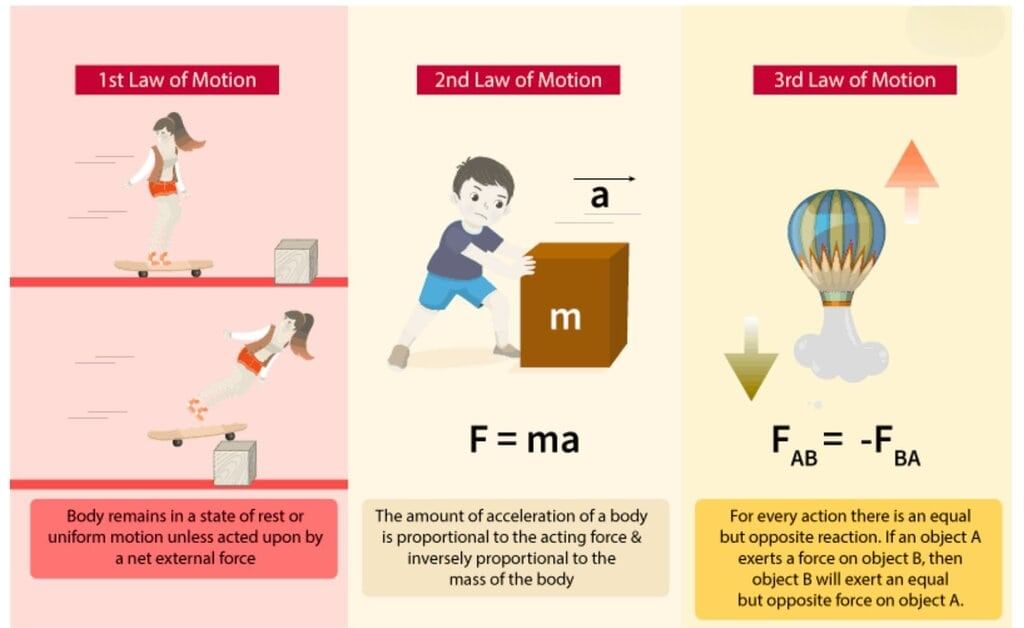Force and Laws of Motion Class 9 Notes Science Chapter 8
Introduction
In our daily lives, we see objects at rest or in motion. A ball rolls, a car accelerates, or a fan spins – all of these are examples of motion. But what causes an object to move or stop? This chapter explores the concept of force and the laws of motion that govern the behaviour of moving and stationary objects. These laws were first scientifically explained by Galileo Galilei and later formulated by Sir Isaac Newton.
What is Force?
A force is a push or pull that changes or tries to change the state of rest or motion of an object. It may also change the shape or size of an object.
- Force is a vector quantity meaning it has both magnitude and direction.
- SI Unit: Newton (N)
- Types of force effects:
- Change in speed (acceleration or deceleration)
- Change in direction
- Change in shape or size (e.g., compressing a spring)

Balanced and Unbalanced Forces
Balanced Forces: When two equal and opposite forces act on an object, it remains at rest or continues to move with constant velocity. These forces do not change the object’s state of motion.
Unbalanced Forces: When the two forces acting on an object are unequal, they produce a change in the object's motion (acceleration or deceleration).
Example: Pushing a box on a rough surface – if you push hard enough to overcome friction, the box will move due to the unbalanced force.
Newton’s First Law of Motion (Law of Inertia)
Statement: Newton's First Law of Motion, also known as the Law of Inertia, states that an object at rest stays at rest, and an object in motion stays in motion with the same speed and in the same direction unless acted upon by an unbalanced force. In simpler terms, objects tend to resist changes to their state of motion or rest.
Key Concept: Inertia
- Inertia: The natural tendency of an object to resist a change in its state of motion or rest.
- Objects with greater mass have greater inertia.
Examples of Inertia
- A passenger moves forward when a bus suddenly stops.
- When a carpet is beaten, dust particles remain in motion (due to inertia) and separate from the carpet.
- Water spills from a glass when the tray is moved suddenly.
Inertia and Mass
- Mass is a measure of inertia.
- More mass = more resistance to changes in motion.
- It’s harder to push a heavy box than a light one because it has more inertia.
Newton’s Second Law of Motion
Statement: The rate of change of momentum of an object is directly proportional to the applied unbalanced force and takes place in the direction of the force.
Mathematical Expression:
F = m . a
- F = Force (N)
- m = Mass (kg)
- a = Acceleration (m/s²)
Momentum
Momentum (p) = mass × velocity
p = m v
SI Unit: kg·m/s
Example:
A car of mass 1000 kg accelerates from 10 m/s to 20 m/s in 5 seconds. What is the force applied?
Sol: Initial velocity, u = 10 m/s
Final velocity, v = 20 m/s
Time, t = 5 s
Mass, m = 1000 kg
Acceleration, a = (v - u)/t = (20 - 10)/5 = 2 m/s²
Force, F = ma = 1000 × 2 = 2000 N
Newton’s Third Law of Motion
Statement: To every action, there is an equal and opposite reaction. These forces act on two different objects.
Key Points:
- Action and reaction forces are equal in magnitude.
- They act in opposite directions.
- They never act on the same body.
Examples:
- Walking: Feet push backwards, ground pushes forward.
- Jumping off a boat: Person moves forward, boat moves backwards.
- Gun recoil: The gun moves backwards when a bullet is fired forward.

Applications of Newton’s Laws
- Sports: A fielder pulls his hands back while catching a fast ball to reduce the impact force (Second Law).
- Driving: Seat belts restrain passengers during sudden stops by counteracting inertia (First Law).
- Jet propulsion: Rockets move forward due to the action-reaction principle (Third Law).
|
84 videos|478 docs|60 tests
|
FAQs on Force and Laws of Motion Class 9 Notes Science Chapter 8
| 1. What is Newton's First Law of Motion and can you provide an example? |  |
| 2. How does Newton's Second Law of Motion explain the relationship between force, mass, and acceleration? |  |
| 3. What is an example of Newton's Third Law of Motion? |  |
| 4. How do these laws of motion apply to everyday activities? |  |
| 5. Why are Newton's laws of motion important in understanding physics? |  |





















